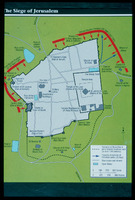The Siege of Jerusalem in 1187
unknown (undetermined)

Download030237_cp.jpg (433.8Kb)
Description
"On 2 October 1187 the Ayyubid sultan Salah al-Din (reg 1169–93) took Jerusalem from the crusaders after a short siege; unlike the crusaders, the Muslims allowed the inhabitants to ransom themselves. The population became predominantly Muslim, as only Christians following the Eastern Rite remained, and Muslim refugees migrated from Ashqelon. For Muslims, Jerusalem acquired an enhanced religious aura because it had been rescued from the crusaders; the city was regarded as a domicile of prophets and saints and scene of the Resurrection and Last Judgement. The walls and citadel were rebuilt, Muslim shrines returned to their original function, and many Christian buildings were rededicated to Islam. The church of St Anne (see fig. 1j), for example, became the Salahiyya Madrasa, named after its founder, Salah al-Din. The hostel of the Knights Hospitaller (1l) was converted into a hospital (Arab. maristan/muristan), which gave its name to the Muristan district. The Christians retained control of the Holy Sepulchre, but pilgrimage to it was suspended until 1192. Sites on the Haram al-Sharif were resanctified, but the original associations were often confused. The buildings of the crusader period provided carved stone spolia for new construction, particularly near the Bab al-Silsila. In 1219, to deter the Christians from retaking Jerusalem and using it as a base, the Ayyubid sultan of Damascus, al-Malik al-Mu'azzam (reg 1218–27), dismantled the fortifications." map, 1993
Type of Work
MapSubject
Battles, Crusades, Maps, Sultans, Conquerors, Sieges, Islam -- History, Ayyubid, Christianity --History, Saladin, Sultan of Egypt and Syria, 1137-1193, Jerusalem in Christianity, Jerusalem in Islam, Jerusalem --History --Latin Kingdom, 1099-1244
Rights Statement
All rights reserved
Item is Part of
122445